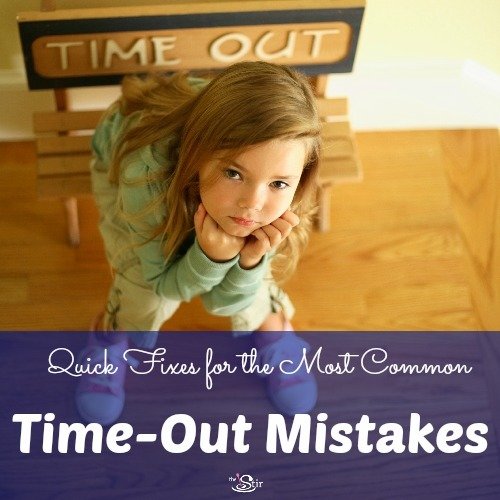If you ask a room full of parents how they discipline their young kids, many are bound to say they use the time-out method. Why? Because it can work. Can being the operative word here. If you ask that same group of parents if time-outs have been completely effective in curbing their kids' negative behavior, a smaller percentage will likely raise their hands. What are these parents doing wrong? Why isn't time-out working for them?
Odds are, they aren't using this strategy correctly.
While there's a lot of controversy surrounding time-outs, to the point where some experts don't approve of them, numerous studies have shown that time-out can be an effective way to manage your child's behavior. In fact, the American Academy of Pediatrics recommends time-outs as an effective discipline strategy, saying that "ignoring, removing, or withholding parent attention to decrease the frequency or intensity of undesirable behaviors" is "especially important in promoting positive child behavior." Thing is, time-outs have to be used properly.
Ready to stop feeling frustrated? Here are common 8 time-out mistakes and easy ways to fix them.

The Mistake: You threaten to use time-out.__
Why It Doesn't Work:__ "Kids often realize that their parents don’t mean what they say, and they will lose respect for your word," says Erik Fisher, PhD, and author of The Art of Empowered Parenting. "Threats that are idle cause more problems than solve them." According to Fisher, your goal shouldn't be for your children to fear you, it should be for them to respect you. "Typically, time-out threats are made with increases in voice volume, because parents think that if they yell louder, their kids will listen," explains Fisher. "That's not the case. They often just learn to turn you off."__
The Fix:__ If you threaten to use time-out, do so with a firm (but not emotional and loud) voice, and be prepared to follow through — no matter where you are. Fisher notes that there are plenty of places to find a space for time-out anywhere you go: On a bench at the mall, in the entryway of a restaurant. Having to stop doing what you're doing may be a little inconvenient for you, but in the long run, always following through will make your time-outs more effective.
The Mistake: You yell at your child the entire time he's in time-out.__
Why It Doesn't Work:__ Kids need time to think while they're in time-out. (And who can do that over a bellowing voice?!) You want them to process what they did and realize why they don't want to do that again. Yelling just makes them feel more resentful about being in time-out and distracts them from the point of it: To think about what they did.__
The Fix:__ Stay calm. "I do not believe in yelling at kids at all, because you end up modeling behavior that you don’t want them to engage in," says Fisher. "Stay calm and model calmness. As a parent, there are times when I want to scream, but I know that the long-term damage that it could do to the trust I have built is not worth the short-term release."
More from The Stir: 3 Toddler Discipline Tricks That Don't Involve Spanking
The Mistake: You keep your child in time-out for too long (or too little).__
Why It Doesn't Work:__ Time-outs typically don't work on fidgety toddlers under the age of two, and most experts agree that attempting this form of discipline on anyone younger is pointless. "Time-outs were originally a way for kids to take a break, think about what they did, maybe even have remorse for it, and settle down and return," says Tovah P. Klein, PhD, author of How Toddlers Thrive. "They don't make sense at all for young children."__
The Fix:__ Some experts recommend the time-out length directly correlate to the child's age — 2 minutes for a 2-year-old; 3 for a 3-year-old — but Fisher believes in equity for kids of all ages. "After the age of 2, time-out for everyone should be 5 minutes," he says. "And time-out does not start until the child is quiet." Of course, every child is different, so your incredibly active 3-year-old might have a tough time sitting quietly for 5 minutes, so feel free to make modifications based on your situation. The important thing is to find something that works and stick to it.
The Mistake: You're emotional when you put your child in time-out.__
Why It Doesn't Work:__ "If your child knows that they are causing you pain by you putting them in time-out, then they will often prolong the pain and continue to disrupt it, so it becomes punishment for you," says Fisher. "They want power over you, because they don’t want you to have power over them."__
The Fix:__ Don't put your child in time-out when you're hysterical. Be swift, firm, and let them know that you mean business. And if they continually disrupt their time-out, don't berate them or act like they are inconveniencing you. Simply help them to understand that they are adding time to their time-out.
The Mistake: Your child actually wants a time-out.__
Why It Doesn't Work:__ When would your child want a time-out? Oh, perhaps when he's in church, or at the grocery store, or in a "boring" situation that you're enjoying. Your kiddo may jump at the opportunity to be in time-out over sitting through a yawn-worthy sermon or walking the aisles of the supermarket again.__
The Fix:__ Don't do the time-out there. "You may have to have them do time-out at home, or lose a privilege," says Fisher. "Just make sure you follow through, and are willing to deal with the issue at that moment."
The Mistake: You talk to your kid when he's in time-out.__
Why It Doesn't Work:__ Time-out is for your child to reflect and think about what he did, not the time to listen to a lecture. Experts advise talking to your kid after the time-out has finished when everyone is calm, and some recommend avoiding even eye contact during a time-out.__
The Fix:__ Once your child has completed his time-out, talk about why he was placed in there. "The three questions I ask kids are: One, is what I did a good idea? Two, did it hurt, harm, or interfere with anyone, anything, or myself? And three, is there a different or better way to do it next time?" says Fisher. "If you talk to them, you engage them, and this gives them a reward for their behaviors. Many times kids will do things when they want attention. If they want your attention, negative attention can be better than no attention at all."
The Mistake: You put your child in his room during time-out.__
Why It Doesn't Work:__ Children's rooms are often fun! They're filled with toys, games, and all sorts of things that will prevent them from truly reflecting on their behavior, which is the point of time-out.__
The Fix:__ Have time-out occur in a "boring" place. Some experts recommend putting your child in a chair facing a blank wall, but if that seems a little harsh, try having a designated time-out room, where there isn't a heck of a lot for your kid to be entertained by, such as a laundry room. Of course, you want to make sure wherever your child is, he's safe, in eye-view, and in a child-proofed space, where he can't get hurt.
The Mistake: You don't give your kiddo lots of "time-in."__
Why It Doesn't Work:__ The inital point of time-out was to withdraw positive reinforcement. If your child isn't accustomed to regular praise and/or a strong bond with you, nothing is really being taken away from him during time out.__
The Fix:__ Encourage positive behavior in your child. When he does something good, let him know! This will get him used to feeling right when he behaves in an appropriate way, and wrong when he doesn't. In turn, it will motivate him to regularly behave more positively. Experts across the board agree: In order for time-out to be effective, he needs a good amount of time-in.
Do you use time-outs with your child? Are they effective?
Images via © Daniel Grill/Tetra Images/Corbis/Corbis




